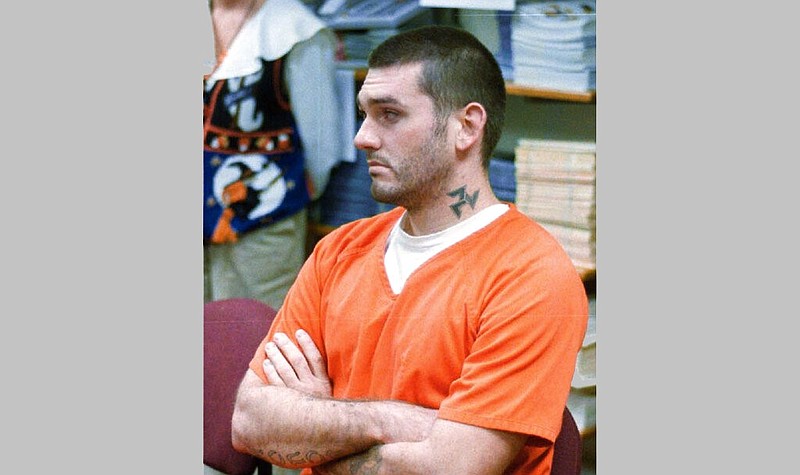TERRE HAUTE, Ind. — The U.S. government on Tuesday morning executed a man convicted 21 years ago of killing a rural Arkansas family and dumping their bodies in a swamp. It was the first federal execution in 17 years.
Prison officials administered the lethal injection to Daniel Lewis Lee at a federal prison in Indiana several hours after a middle-of-the-night ruling from the U.S. Supreme Court removed the final legal hurdle blocking the killer’s death.
With his body under a sheet and arms strapped tightly to the gurney, Lee raised his head and — with his one good eye — stared at the gaggle of reporters on the other side of the glass to make his final statement.
“I made a lot of mistakes in my life, but I’m not a murderer,” he said. “They’re killing an innocent man.”
The lethal drug was administered intravenously to Lee shortly after 7:45 a.m. EDT, and he was pronounced dead at 8:07 a.m.
Lee, 47, of Yukon, Okla., had been scheduled to die on Monday, but a federal judge in Washington, D.C., granted an injunction hours before the scheduled execution. After a day of legal wrangling, the U.S. Supreme Court lifted the stay early Tuesday by a 5-4 vote.
After 21 years on death row, Lee looked older, heavier and more haggard. The one remaining unmistakable feature was his missing left eye, which he had lost in a bar fight as a young adult.
As the drug was being administered, Lee was flanked by a federal marshal and a senior official with the Bureau of Prisons. He moved his head back and forth and uttered a few statements, which were inaudible from the witness room.
After several minutes, his breathing became more labored. He twitched his right foot and moved his head slightly to the left, where it stayed for the next 10 minutes.
A doctor from behind another glass window got on the microphone and pronounced him dead.
Lee was convicted and sentenced to death in the January 1996 slaying of a family of three outside Tilly. He and his accomplice, Chevie Kehoe, duct-taped plastic bags to each victim’s head and dumped the bodies in a bayou near Russellville.
The victims were William Mueller, 52; his wife, Nancy, 28; and her 8-year-old daughter, Sarah Powell.
Unlike Lee, Kehoe was sentenced to life in prison despite testimony that he planned the slayings and was the one who killed the 8-year-old girl.
U.S. Attorney General William Barr said Lee deserved the punishment for his “horrific” crimes.
“Today, Lee finally faced the justice he deserved,” Barr said.
Reporters were assigned to a viewing area separate from the other witnesses, who could not be seen by the reporters. The Associated Press reported that a few of Lee’s family members were present for his execution.
The victims’ family members who attended declined to speak to reporters. There was no news conference afterward.
As Monday afternoon stretched into night, it seemed more and more likely that Lee’s execution would be rescheduled for a later date as an appeals court continued to accept attorneys’ briefings and review them. Around midnight, the court announced it would not overturn the injunction handed down early Monday by a federal judge. The government quickly appealed to the Supreme Court.
Shortly after 2 a.m. Tuesday, prison officials contacted media witnesses, including a reporter with the Arkansas Democrat-Gazette, notifying them of the Supreme Court’s ruling and that Lee would be executed at 4 a.m. Reporters were escorted into the viewing room around 4:20 a.m.
Prison officials said witnesses are not allowed into the viewing room until after the inmate is strapped to the gurney, but before the curtains could be raised, attorneys for Lee filed a last-ditch motion, which delayed the execution for more than three hours.
During the wait, a spokeswoman with the Bureau of Prisons told reporters that Lee’s attorneys raised a “technical legal issue” at the last minute.
One of Lee’s attorneys, Ruth Friedman, issued a blistering statement Tuesday in reaction to the way the execution was handled. She called the federal government “beyond shameful” in its pursuit of ending Lee’s life. It did so, she said, “in haste.”
Friedman also said she thought the government was being cruel by strapping down Lee before attorneys were finished with their efforts to save him.
“Daniel Lewis Lee remained strapped to a gurney: a mere 31 minutes after a court of appeals lifted the last impediment to his execution at the federal government’s urging, while multiple motions remained pending,” she said, “and without notice to counsel, he was [eventually] executed.”
The filing that delayed the execution from 4:30 a.m. to just before 8 a.m. was the last of a series of legal maneuvers spread across months that resulted in stays, overturned injunctions and postponements.
Monday was the most eventful day of all for many of the attorneys and judges involved in the case.
U.S. District Judge Tanya Chutkan on Monday enjoined government officials from executing Lee based on legal issues pertaining to the federal government’s lethal injection protocol, suggesting it amounted to cruel and unusual punishment. Chutkan had stayed Lee’s originally scheduled execution in December over similar concerns about the drug.
Lee was executed with pentobarbital, a barbiturate that disables the brain and nervous system.
Various inmates had filed a motion alleging that the government’s use of pentobarbital would cause sensations commonly associated with drowning or strangulation. In her ruling on the motion Monday, Chutkan sided with the inmates, stating the drug “poses an unconstitutionally significant risk of serious pain.”
The U.S. Court of Appeals for the D.C. Circuit overturned Chutkan’s stay from December, but on Monday, it refused to overturn her latest order. That’s when the Trump administration asked the Supreme Court to lift the injunction.
Supreme Court Justices Stephen Breyer, Sonia Sotomayor, Ruth Bader Ginsburg and Elena Kagan dissented from the majority.
In his dissenting opinion, Breyer stated, “As I have previously written, the solution may be for this Court to directly examine the question whether the death penalty violates the Constitution.”
While the use of the death penalty has declined nationwide, the state of Arkansas executed four inmates in 2017, using a three-drug protocol that has also faced legal challenges. There has not been an execution in the state since 2017 because of a combination of legal challenges and difficulties maintaining a supply of execution drugs.
The high court’s Tuesday decision also puts back on schedule three more federal executions that had been lined up by the federal government in Terre Haute. Two of them are set for this week. Like Lee, the other three death row inmates were convicted in murders involving children. Those killings occurred in Missouri and Iowa.
A few of Nancy Mueller’s family members had sought a delay in the execution because they didn’t want to travel thousands of miles in the midst of a pandemic to watch Lee be put to death. Their filing led to an Indiana judge granting a stay Friday, but an appeals court overturned that Sunday.
Those same family members have publicly said they were opposed to Lee’s execution.
Robert Dunham, executive director of the Death Penalty Information Center in Washington, D.C., accused federal authorities of not maintaining a “scrupulous adherence to the law” as they moved to execute Lee and the other three men awaiting executions.
“These death warrants … disrespect the judicial process,” Dunham wrote.
He went on to state that the Justice Department set new execution dates this year “knowing full well that additional issues … were being actively litigated.” He, like Friedman, suggested the entire process was accelerated on purpose.
“The execution dates’ proximity in time to the issuance of the death warrants guaranteed that prisoners could not litigate all claims before their imminent execution dates,” he said.
The Death Penalty Information Center doesn’t take a position for or against the death penalty but has regularly been critical of how it is carried out.
A counterpoint to Dunham’s opinion was offered Tuesday by U.S. Sen. Tom Cotton, R-Ark. He said the wait for Lee’s punishment to be carried out has been too long.
“Two decades ago, a jury imposed the death penalty on a man guilty of murdering an Arkansas family, including a young girl,” he said. “After 20 years of delays by activist judges, justice has finally been served for his heinous crimes.”
Information for this article was contributed by John Moritz of the Arkansas Democrat-Gazette.

